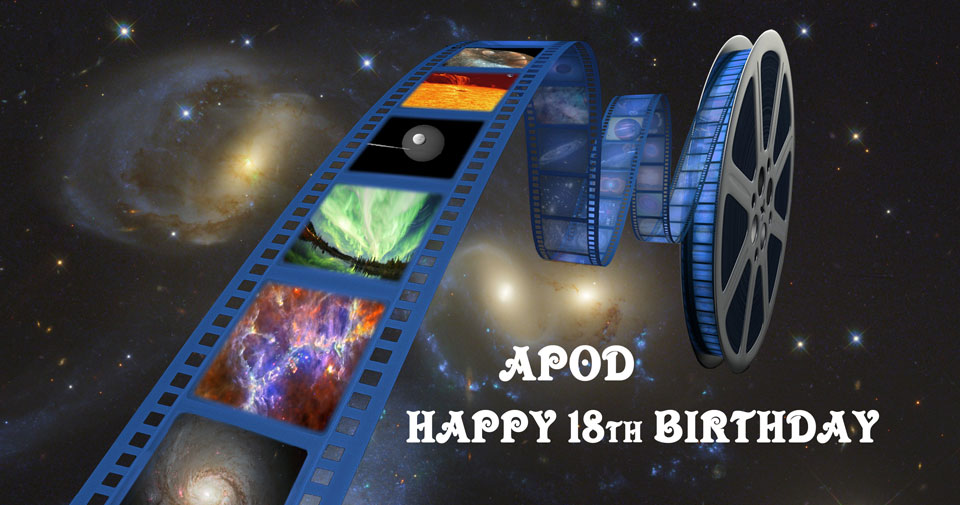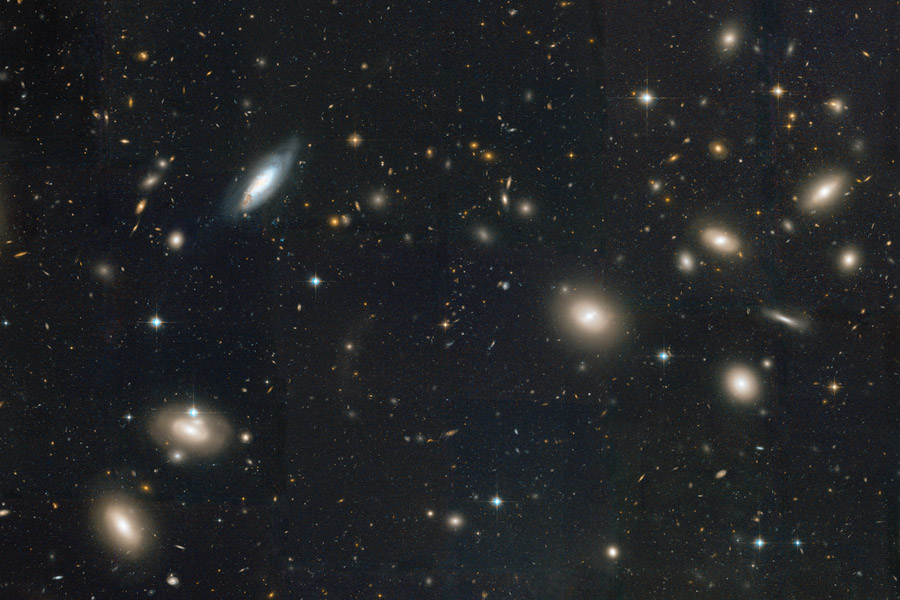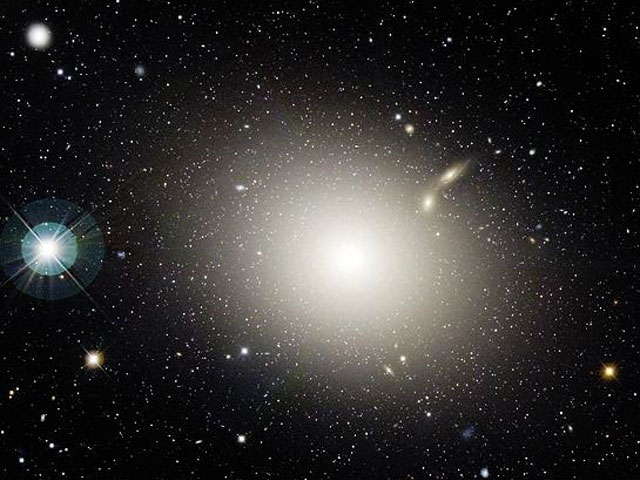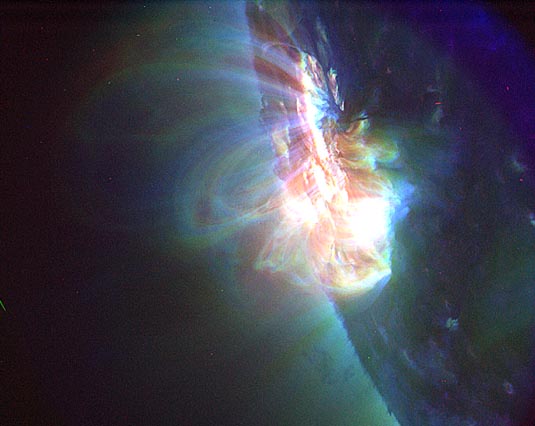Happy Anniversary, APOD!
| << Previous | Index | Next >> |
2015
[imghover6=http://apod.nasa.gov/apod/image/1506/ve ... on_960.jpg]http://apod.nasa.gov/apod/image/1506/ve ... er_960.jpg[/imghover6]Apologies to: Vermeer's Astronomer and Geographer;
Image Pixelation: Rob Stevenson
Image Pixelation: Rob Stevenson
2014
Image Credit: Stuart Lowe, LCOGT/Virtual Sky
2013 The first APOD appeared eighteen years ago today, on 1995 June 16. Although garnering only 14 pageviews on that day, we are proud to estimate that APOD has now served over one billion space-related images over the past eighteen years. That early beginning, along with a nearly unchanging format, has allowed APOD to be a consistent and familiar site on a web frequently filled with change. Many people don't know, though, that APOD is now translated daily into many major languages. We again thank our readers, astrophotographers, and NASA for their continued support, but ask that any potentially congratulatory e-mail go this year to the volunteers all around the world who translate APOD's captions daily, many times with considerable effort. Some APOD images are featured in the above spectacular collage visualizing APOD as a classic film reel, submitted by an APOD enthusiast skilled in digital image manipulation. How many APOD images can you identify?
2012
[imghover6=http://apod.nasa.gov/apod/image/1206/ap ... on_960.jpg]http://apod.nasa.gov/apod/image/1206/ap ... otated.jpg[/imghover6]Image Credit & Copyright: Judy Schmidt
2011 The robotic MESSENGER spacecraft recently completed over 100 orbits of Mercury. MESSENGER's cameras have recorded detailed pictures utilizing eight different colors across visible and near infrared light, exploring the surface composition and looking for clues to the history and evolution of the solar system's innermost planet. This sharp image combines three of the MESSENGER wide angle camera's colors, but in exaggerated fashion. Otherwise, to the unaided human eye, Mercury's surface colors would appear comparatively muted. The image is about 1,000 kilometers across and features as small as a single kilometer are discernible at the original resolution. Today, the MESSENGER project will release new images and science findings from the first spacecraft to orbit Mercury.
2010
[imghover6=http://apod.nasa.gov/apod/image/1006/ve ... venson.jpg]http://apod.nasa.gov/apod/image/1006/ve ... ermeer.jpg[/imghover6]Apologies to: Vermeer's Astronomer and Geographer;
Image Pixelation: Rob Stevenson
Image Pixelation: Rob Stevenson
2009
[imghover6=http://apod.nasa.gov/apod/image/0906/mo ... sisman.jpg]http://apod.nasa.gov/apod/image/0906/mo ... n_hb14.jpg[/imghover6]Credit & Copyright: Tahir Sisman
On the occasion of our 14th anniversary
On the occasion of our 14th anniversary
On the occasion of our 14th anniversary, the APOD editors thank all of our contributors and mirror site operators whose volunteer efforts help bring the wonders of astronomy to millions of people around the world. Additional thanks also go to our Turkish mirror site operators for submitting the above mouseover image.
2008
2007 To prepare for the Apollo landings, five Lunar Orbiter spacecraft were launched during 1966 and 1967 to gather detailed images of our fair planet's large, natural satellite. Dramatic views returned by the spacecraft cameras included this stark moonscape. The mosaic of 93 kilometer wide impact crater Copernicus features central peaks rising above the crater floor and rugged crater walls.
Note: As of today, June 16, the APOD editors have enjoyed presenting images from space missions, major observatories, and professional and amateur cosmic tourists alike for twelve years. A sincere thanks to our web site operators, translators, and to all for the gracious email and continued APOD submissions!
2006 The first APOD appeared eleven years ago today, on 1995 June 16. Although garnering only 14 page views on that day, we are proud to estimate that APOD has now served over 400 million space-related images over the last eleven years. That early beginning, along with a nearly unchanging format, has allowed APOD to be a consistent and familiar site on a web frequently filled with change. Many people don't know, though, that APOD is now translated daily into many major languages. We again thank our readers and NASA for their continued support, but ask that any potentially congratulatory e-mail go to the folks who created the great pictures -- many times with considerable effort -- that APOD has been fortunate enough to feature over the past year. Many can be contacted by following links found in the credit line under the image. Some of these images are featured in the above spectacular collage of a fantasy sky above Mars submitted by an enthusiastic APOD reader skilled in digital image manipulation. How many APOD images can you identify?
2005
2004
2003 The first APOD appeared eight years ago today, on 1995 June 16. To date, we estimate that APOD has now served over 100 million space-related images. We again thank our readers and NASA for their continued support, but ask that any potentially congratulatory e-mail go to the folks who created the great pictures -- many times with considerable effort -- that APOD has been fortunate enough to feature over the past year. Many can be contacted by following links found in the credit line under the image. Some of these images are featured in the above spectacular collage submitted by an enthusiastic APOD reader well skilled in digital image manipulation. She challenges fellow APODees to find in the collage her favorite ex-member of the musical group Tangerine Dream.
2002
2001 Welcome to the seventh year of Astronomy Picture of the Day (APOD). Editors Robert Nemiroff and Jerry Bonnell are extremely grateful for the continued large volume of gracious e-mail and APOD submissions (and also for the "occasional" critical note!). Today we would like to offer a very sincere thank you to all. We are certainly proud that each day over the last six years APOD has consistently coupled an expanding universe of hypertext with inspiring images of the cosmos. In fact, tomorrow's picture might actually be ...
2000 Welcome to the sixth year of Astronomy Picture of the Day (APOD)! Above are the industrious Robert Nemiroff (left) and persistent Jerry Bonnell (right), still engaged in creating the APOD web pages. As suggested by imagery in this recently released Vermeer, APOD's origins derive from many dramatic, intellectual deliberations over the ultimate value of the World Wide Web. In our view, the WWW has evolved into a significant and still growing collective human resource and we think it's important to contribute. We are extremely grateful for the continued large volume of gracious e-mail and APOD submissions. Today we would like to offer a very sincere thank you to all. We are certainly proud that each day over the last five years APOD has consistently coupled an expanding universe of hypertext with inspiring images of the cosmos. In fact, tomorrow's picture might actually be ...
1999
1998 The Sun is a busy place. This false-color image depicts an active region near an edge of the Sun. Hot plasma is seen exploding off the Sun's photosphere and traveling along loops defined by the Sun's magnetic field. The red regions are particularly hot, indicating that some magnetic field loops carry hotter gas than others. These active loops were so large that the Earth could easily fit under one. The TRACE satellite was launched in April with plans to continue high-resolution imaging as the Sun passes Solar Maximum in the next few years.
1997 The first Astronomy Picture of the Day (APOD) appeared two years ago today. Pictured above is a scene surrounding the creation of an early APOD, depicting the famous astronomer Tycho Brahe demonstrating a celestial globe to Emperor Rudolph II. The image of a possible optical counterpart to a gamma-ray burst appears on the back wall. In Tycho's day, humanity discovered the nature of the Earth and the geometry of the Solar System. The times we live in are even more fascinating as we explore the nature of our Solar System and the geometry of our whole universe. APOD continues to chronicle these events by finding, presenting ,and annotating the most important astronomical pictures of our time, and cataloging them in an indexed and searchable archive. Link to APOD and discover the cosmos! With over five million pages served, we thank NASA, Michigan Tech, USRA, and most of all our readers, for their continued support.
1996 The first Astronomy Picture of the Day (APOD) appeared one year ago today. Pictured above are Robert Nemiroff (left) and Jerry Bonnell (right), engaged in creating the APOD web pages. APOD started over speculative conversations on the ultimate value of the World Wide Web. In our (current) view, the WWW is the closest thing yet to an "Encyclopedia of Humanity," and we think it's important to contribute. We are proud to say that APOD has now annotated most of the famous astronomical pictures of our time and has made them available to the general public in an indexed and searchable archive. During it's first year, APOD's main daily picture page has been served over one million times. But APOD's mission continues. As space science progresses more pictures, fresh insights, and new educative links become available. Therefore, so long as public interest and NASA support continue, APOD will continue. We thank all whose gracious e-mail are continually a source of encouragement.
1995 If the Earth could somehow be transformed to the ultra-high density of a neutron star , it might appear as it does in the above computer generated figure. Due to the very strong gravitational field, the neutron star distorts light from the background sky greatly. If you look closely, two images of the constellation Orion are visible. The gravity of this particular neutron star is so great that no part of the neutron star is blocked from view - light is pulled around by gravity even from the back of the neutron star.
| << Previous | Index | Next >> |














